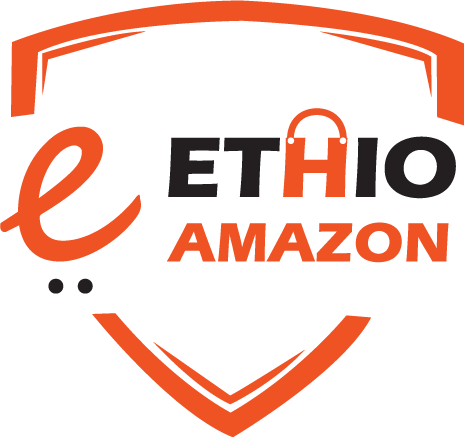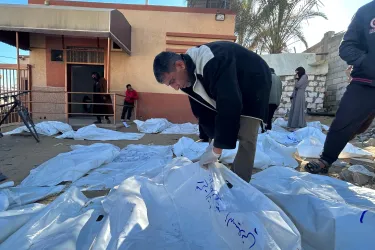‘Skull without a jaw’: Gaza survivors search for what remains of the dead Leave a comment
Khan Younis, Gaza Strip, Palestine – With a heavy heart, keen eyes and trembling hands, Abu Muhammed Ghaith meticulously searched through the thick nylon bags used as makeshift shrouds for those killed in Gaza. Inside the morgue at Nasser Hospital in the southern city of Khan Younis, he was hoping to find a trace of his missing son. Instead, he was met only with unidentified body parts and fragmented remains.
The sight left him collapsed on the ground, overwhelmed by grief and exhaustion. Yet, he gathered his strength and continued searching for any trace of 17-year-old Muhammed, shifting his focus from bodies to personal items: a pair of sandals patched with yellow plastic or an orange sweater, a black jacket, tracksuit pants – anything that could belong to his son.
Khan Younis, Gaza Strip, Palestine – With a heavy heart, keen eyes and trembling hands, Abu Muhammed Ghaith meticulously searched through the thick nylon bags used as makeshift shrouds for those killed in Gaza. Inside the morgue at Nasser Hospital in the southern city of Khan Younis, he was hoping to find a trace of his missing son. Instead, he was met only with unidentified body parts and fragmented remains.
The sight left him collapsed on the ground, overwhelmed by grief and exhaustion. Yet, he gathered his strength and continued searching for any trace of 17-year-old Muhammed, shifting his focus from bodies to personal items: a pair of sandals patched with yellow plastic or an orange sweater, a black jacket, tracksuit pants – anything that could belong to his son.
Khan Younis, Gaza Strip, Palestine – With a heavy heart, keen eyes and trembling hands, Abu Muhammed Ghaith meticulously searched through the thick nylon bags used as makeshift shrouds for those killed in Gaza. Inside the morgue at Nasser Hospital in the southern city of Khan Younis, he was hoping to find a trace of his missing son. Instead, he was met only with unidentified body parts and fragmented remains.
The sight left him collapsed on the ground, overwhelmed by grief and exhaustion. Yet, he gathered his strength and continued searching for any trace of 17-year-old Muhammed, shifting his focus from bodies to personal items: a pair of sandals patched with yellow plastic or an orange sweater, a black jacket, tracksuit pants – anything that could belong to his son.
‘A few bones’
In the days since the Israeli military partially withdrew from Rafah, local rescue teams and medical staff have recovered dozens of remains and body parts, which were transported to the Nasser and European hospitals in Khan Younis for identification. With the news circulating, families with missing loved ones have flocked to these sites, hoping to find closure.
Since the day he went missing, Abu Muhammed spared no effort in searching for him. He contacted the Red Cross, the Ministry of Health and anyone who might help. He even returned to his destroyed home in Rafah, combing through its rubble. “I’ve looked everywhere. His mother is on the verge of losing her mind, and his sisters are desperate for answers,” he said.
The war has killed about 47,000 people, according to Gaza’s Health Ministry. However, the globally-renowned Lancet medical journal expects the actual number of deaths to be 41 percent higher than the announced toll.
In May, the United Nations humanitarian arm, OCHA, said more than 10,000 people were believed to be buried under the rubble in Gaza, adding that it could take up to three years to retrieve those bodies, given then the very primitive tools in the territory.
After hours of sifting through the rubble of his destroyed home in Rafah, a heartbroken Faraj Abu Mohsen found no trace of his son. On his way back to Khan Younis, where his family is displaced, the 42-year-old came across body parts and torn clothing about 200 metres (656 ft) from the ruins of his house – items he recognised as belonging to his son.
“I had given up hope of finding him alive. While walking back to Khan Younis after searching all day, my foot struck some bones. I moved them aside and uncovered clothing that belonged to my son – his black shirt, blue pants, and sneakers. I knew it was him,” Faraj recalled, sorrowfully. He gathered the remains in a bag, buried what he could, and promised to return to search for more.
“None of us imagined that all we’d have left of him would be a few bones,” he said, his voice heavy with grief.
Challenges of identification
Inside and outside the morgue at Nasser Hospital, a heart-wrenching scene unfolded. Desperate families described physical features or clothing in the hope of identifying their loved ones.
“My son recently had a tooth implant,” one mother said.
Another father called out, “He was wearing blue jeans.”
Others spoke of height, build, or unique items like a cowboy hat or a patched sandal.
Adding to the pain were the stark labels written on the shrouds: “Skull without a lower jaw”, “Bone fragments”, “Rib cage”, or “Upper and lower limbs”. Instead of names and ages, medical teams documented the details left of Palestinians slain by Israeli artillery to help families identify the remains. Alongside these notes were descriptions of personal items found with the remains – rings, watches, shoes, or damaged ID cards.
The lack of DNA testing capabilities in Gaza significantly hampers identification efforts, Dr Ahmed Dhahir, a forensic medicine consultant with Gaza’s Health Ministry, explained, adding that Israel has long restricted the entry of DNA testing equipment into the Strip. “Without this technology, many bodies remain unidentified, leaving families in perpetual anguish,” he said.
Dr Dhahir outlined the identification process: remains are first retrieved by rescue teams, then examined and documented. Details such as the recovery location, date and any personal items are recorded. Given the state these bodies have been found in, forensic experts rely heavily on circumstantial evidence, such as clothing or belongings, to guide families.
“We follow legal protocol by keeping the bodies for up to 48 hours to allow families an opportunity to identify them. After that, the remains are buried by the Ministry of Endowments and Civil Defence in a designated cemetery, with specific numbers and records maintained for potential future identification if testing equipment becomes available,” Dr Dharir said.
He also noted that one-third of the remains recovered from Rafah so far – about 150 cases – remain unidentified.
“The most challenging cases are those involving partial remains: a skull, leg bones or fragments of a ribcage. These are carefully numbered and catalogued, but without DNA testing, definitive identification is often impossible,” he added.
Families in limbo
Current forensic resources in Gaza are limited, with only three specialists available in the southern region and none in the north, Dr Dhahir explained, adding that this shortage strained an already overwhelmed system, especially with the sheer volume of remains recovered following Israeli attacks.
For families like Abu Muhammed’s, the inability to locate or identify loved ones prolongs their grief. “We just want to know his fate,” Abu Muhammed said. “Even if all that’s left of my son is a bone, we want to bury him and say goodbye.”
The forensic teams face mounting pressure, not just from families but also from the growing backlog of remains. Dr Dhahir emphasised the need for international assistance. “We urgently need DNA testing equipment and trained specialists to help identify victims. This is not just about closure for families – it’s a humanitarian necessity,” he said.
As efforts continue, families cling to hope, no matter how faint. For Abu Muhammed, the search for his son has become a daily ritual, one he cannot abandon despite the emotional toll. “I’ve lost count of the shrouds I’ve opened. I don’t know if I’ll ever find him, but I’ll keep searching,” he said.
The tragedy of unidentified remains underscores the broader human cost of the conflict. Beyond the staggering death toll lies an equally painful reality: families left in limbo, searching for answers amid the rubble of their lives.
For many, closure feels like an unattainable dream – one stolen by war and the lack of resources to mend its wounds.
This piece was published in collaboration with Egab.
- If you are looking to order local products, handcraft, custom clothes, various books, handmade arts, furniture’s, food spices etc. please, visit our web page at www.ethio-amazon.com. Or send us your request at email contact@ethio-amazon.com you can also contact us on WhatsApp at +2519-44-36-97-53
Additionally, if you would be interested to socialize and looking for a new friend around the world, for future partnership… visit our web page at www.contactyourlifepartner.com
We believed that love can happen anytime, anywhere in a world filled with endless possibilities… for more information contact us at Email contact@ethio-amazon.com or Call us at +2519-44-36-97-53 (WhatsApp),
+ 6676539901 (international)Source (Al jazeera News)

